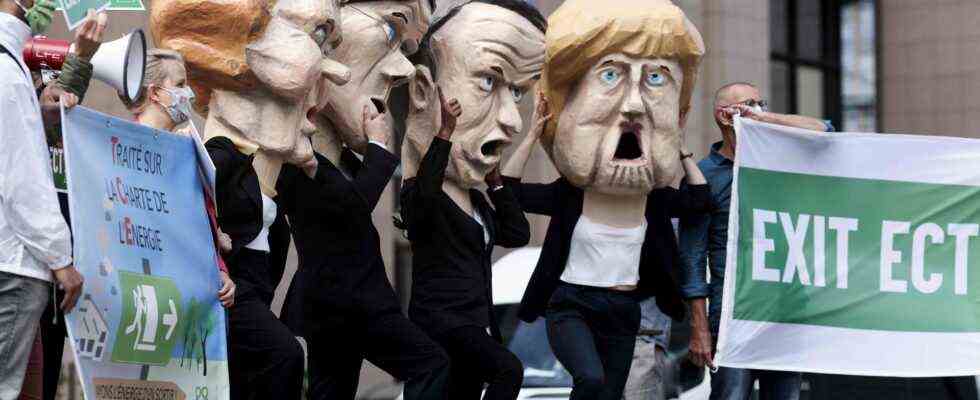background
Status: 07/14/2021 4:20 a.m.
Greenhouse gas emissions from the EU are expected to decrease by 55 percent by 2030. To this end, the EU Commission wants to reorganize its climate regulations. An overview of the most important “Fit for 55” measures presented today.
From Jakob Mayr,
ARD studio Brussels
The EU Commission is not just turning a few screws, but the big wheel: In twelve legislative proposals, it outlines the restructuring of the European way of life and economy. Anyone who processes steel in Germany, drives a car in France, runs a company in the Czech Republic, or heats an apartment in Finland will feel it. Commission President Ursula von der Leyen compared the “Green Deal” with the moon landing. Now your authority is showing what the missile could look like. The Commission is using all available instruments: It is increasing the CO2 price – within the framework of emissions trading – setting stricter standards for engines and proposing higher energy taxes.
Is that the end of the combustion engine?
Around a quarter of Europe-wide CO2 emissions currently come from traffic. In order to curb them, the Commission wants to introduce a further emissions trading system in the transport and building sectors in addition to the emissions trading scheme that applies to other economic sectors. That could make gasoline and heating oil more expensive – and should provide incentives to buy economical cars and to insulate them better. Even stricter CO2 limits for new cars are intended to encourage car manufacturers to quickly develop vehicles with lower emissions.
According to the Vice President of the EU Commission, Frans Timmermans, cars will have to emit 60 percent less CO2 from 2030 onwards, and none at all in 2035. The requirement to make Europe climate-neutral by 2050 already means that by then there must be no more cars on the road that are not emission-free. Based on the average car service life, the internal combustion engine will probably have had its day by the middle of the next decade. Alternatively, vehicles could be powered by hydrogen, synthetic fuels or biofuels. However, the production of these e-fuels is very expensive.
E-charging stations in all EU countries
The number of electric cars registered in Germany is still manageable, but their number is increasing rapidly. To make e-cars more popular, many more charging stations are needed. The Commission will probably set corresponding expansion targets for the member states. The European manufacturers’ association Acea supports this. According to its information, charging stations are very unevenly distributed in the EU: 70 percent are in just three countries, namely the Netherlands, France and Germany. The rest is undersupplied.
Emissions trading rebuilt
Since 2005, the EU has been trying to protect the climate with market-based instruments: Operators of industrial plants that produce in a climate-friendly manner can sell their pollution rights to companies that need more certificates. Emissions trading covers around 40 percent of emissions in the EU and applies to around 12,000 companies: power plants, cement factories, refineries, steel works. In the future, it will be significantly more expensive for industry to emit CO2: Free allocations of emission rights will be reduced, the number of certificates will be reduced again, which will cause prices to rise.
Protection from foreign competition
EU companies have to do more for the climate – they are in competition with companies in the rest of the world, which often apply lower standards. Brussels proposes a border adjustment mechanism to prevent unfair competition and the brain drain of European companies. Anyone who imports steel, aluminum, cement, fertilizer or electricity into the EU from outside the EU, which were produced in a less climate-friendly manner, must pay a fee.
Business associations fear disadvantages for EU companies that have to compete with companies on non-European markets where no mechanism protects them. Important trading partners like the USA or China are skeptical.
Ships and planes are also involved
Airlines and trade unions are already worried about companies and hubs that are only just recovering from the consequences of the pandemic: The EU Commission is proposing a step-by-step increase in the minimum tax rate on kerosene for flights within Europe, which has so far not been taxed, apart from national exceptions. In addition, sustainable aviation fuel is to be added to the fuel. To this end, levers could be tightened in emissions trading for aviation by reducing the number of available certificates more quickly or issuing fewer free credits.
On the water, every ship calling at a European port should have a climate-friendly fuel mix in its tank that meets EU requirements. It is also planned to set an average fleet consumption for both ships and cars.
Social fund is intended to compensate for differences
Not all EU countries have the same amount of money to finance the transformation – in other words: not all citizens can easily afford the change. A social climate fund is to help member states to set up a network of charging stations on the flat land. At the same time, low-income households in the EU countries are to be supported when they renovate their houses or plan to switch to electric cars. The fund is fed by income from the border adjustment tax and emissions trading.
In a total of twelve directives and regulations that directly affect the lives of 450 million people in Europe, the EU wants to become climate-fit. In the end, the European Parliament, the Commission and the Member States have to come to an agreement – the debate is on and it will last for months, if not years.
Fit for 55: The traffic turnaround is getting serious for the auto industry
Helga Schmidt, WDR Brussels, July 14, 2021 6:32 a.m.

